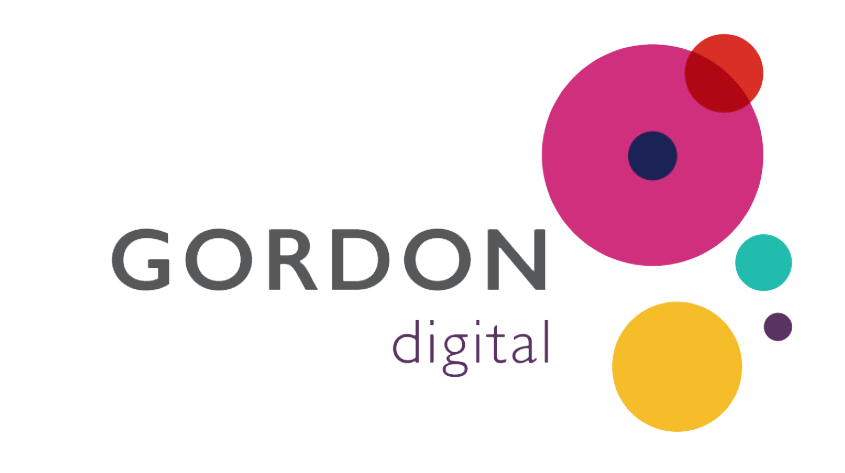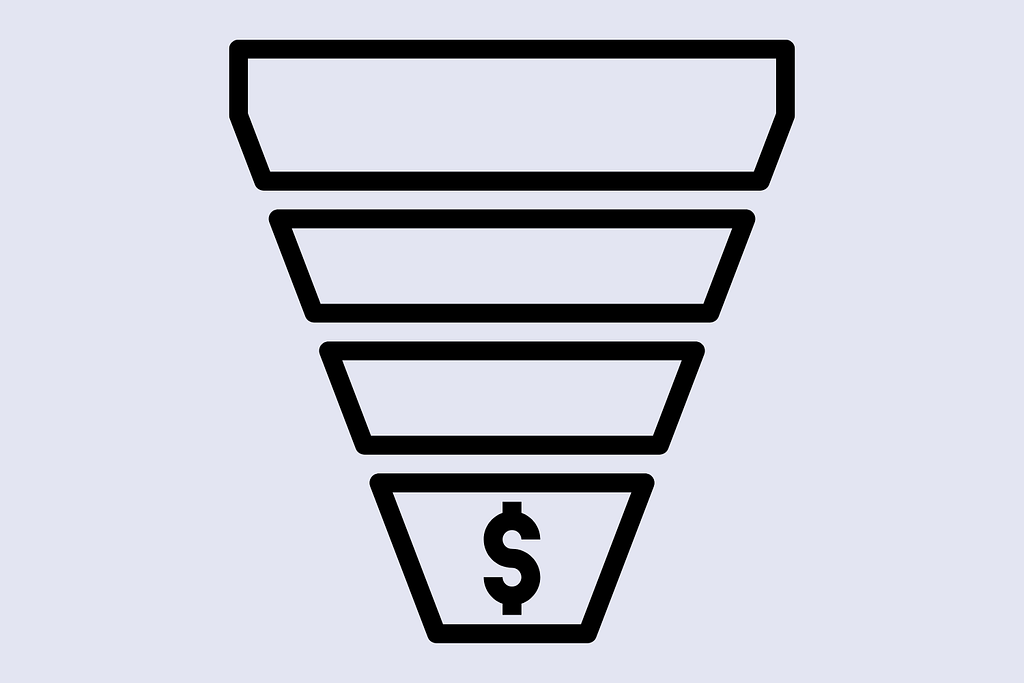
Key Takeaways
- There are four stages to a digital marketing funnel: Awareness, Discovery, Conversion and Retention.
- TOFU, MOFU and BOFU are industry terms that refer to the top, middle and bottom of the marketing funnel.
- A successful digital marketing funnel starts with audience research. When you understand your ideal shopper you can create more targeted campaigns.
- It can be up to 10 times cheaper to retain existing customers than to gain new ones.
- Your digital marketing funnel should continue after the sale is complete to nurture existing customers and encourage repeat business.
What is a Digital Marketing Funnel?
A digital marketing funnel is a framework used to outline the process that guides users from prospects through becoming repeat customers. Most marketing funnels consist of 4 stages: Awareness, Discovery, Conversion and Retention.
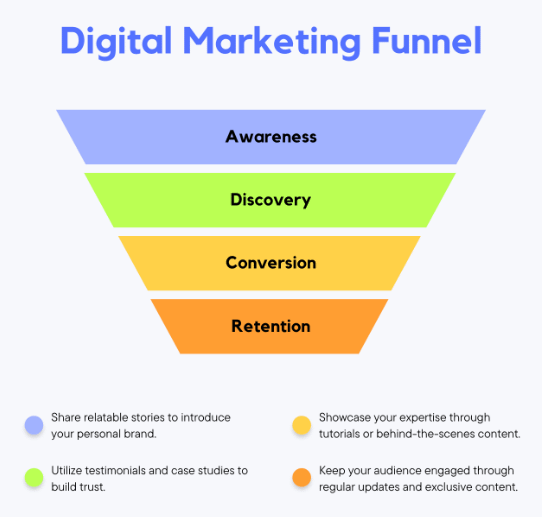
You could think of a digital marketing funnel as a plan of action. It helps to structure your work and ensures the separate parts of your marketing campaign all work towards the same goal.
As the name suggests, digital marketing funnels are funnel-shaped.
Each of your marketing activities falls into one of the four segments. At each part of the funnel, your marketing encourages customers to progress to the next phase.
Activities at the top of the funnel target a broad audience. As potential customers move down the funnel, the focus gets narrower until the sale is secured.
This is a great tool for identifying problems with your marketing campaigns.
For example, if you’re struggling to reach potential customers, you need to improve the brand awareness campaign at the top of your funnel. Or, if your visitors are abandoning their carts at the bottom of the funnel, you need to figure out why and try to bring them back.
By keeping track of what works and what doesn’t, you can create highly targeted campaigns. Your team can invest in high-quality content that gives value to your audience. This all contributes to achieving the ultimate goal – brand loyalty.
Phase 1: Awareness
A digital marketing funnel begins with “Awareness”. For a potential customer, this is the first impression of your brand.
There are a range of strategies that can build awareness. With global ad spend set to expand by 7.4% this year, it’s likely your competitors are using Google Ads and SEO to reach new customers. Informative blog posts, videos and social media can also be part of the “Awareness” mix.
Customer research will help you attract the right visitors. You need to know who you’re targeting and how your product or service can benefit them. Once you understand the needs and wants of your ideal customers, you’ll be able to create more targeted marketing campaigns.
Phase 2: Discovery
The second phase is “Discovery”. The potential customer is aware of your business and is curious to learn more. They may spend time on your website, view your company’s social media profiles or email you with a list of questions.
Your marketing strategy should focus on helping customers find the information they’re looking for. This includes things like:
- Writing valuable and informative content for your website
- Improve the user experience of your website
- Making sure staff are available to answer questions
- Adding chatbots to your website and social media profiles to answer simple questions
- Asking existing customers to provide reviews
During the “Discovery” phase, most shoppers will want feedback from previous customers before making a final decision. Almost 70% of people read 1-6 reviews before handing over their money. They want genuine feedback about service, price, quality, durability and more.
Make sure you include customer testimonials on your website and encourage external reviews.
Phase 3: Conversion
We now move onto the “Conversion” phase.
The customer has done their research and likes what you have to offer. If they still need a nudge, a discount or direct Call To Action (CTA) may seal the deal.
Getting to the “Conversion” phase means your hard work has paid off. But you aren’t over the finish line yet. You need to make it easy for the customer to purchase your product or service.
For example, you can accept multiple payment methods, provide a seamless checkout experience, or offer small discounts to new users.
Phase 4: Retention
The final phase of the digital marketing funnel is “Retention”.
Acquiring new customers can cost up to 10 times more than retaining an existing one. So, retention makes good financial sense.
Loyalty is earned, so you need to maintain high levels of customer service and quality products to encourage repeat business. We recommend doing things like:
- Use remarketing to target past customers
- Send out an informative newsletter
- Use email marketing to update customers about special offers and events
- Implement a loyalty program
- Pick up the phone and stay in touch with your best customers
The key here is to go the extra mile. Little details can earn lots of loyalty, so don’t be afraid to make sure your customers know they’re valued.
What do TOFU, MOFU, and BOFU Mean?
Marketers often refer to the parts of a marketing funnel as TOFU, MOFU and BOFU. This is just another way to describe the main parts of the funnel:
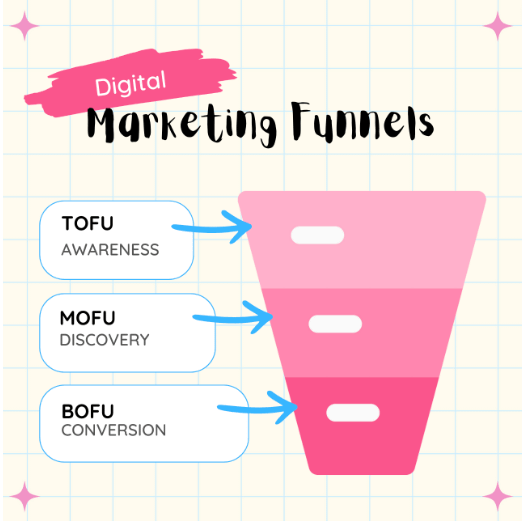
It’s similar to the funnel we outlined above. The terms stand for:
- TOFU: Top-of-funnel – the Awareness phase.
- MOFU: Middle-of-funnel – the Discovery phase.
- BOFU: Bottle-of-funnel – the Conversion and Retention phases.
What is a Looping Marketing Funnel?
A looping marketing funnel is also known as a loyalty loop. This is a retention strategy designed to keep customers buying, buying and buying again.
Your visitors still move through the funnel stages as above, but once they make a purchase, the process starts again.
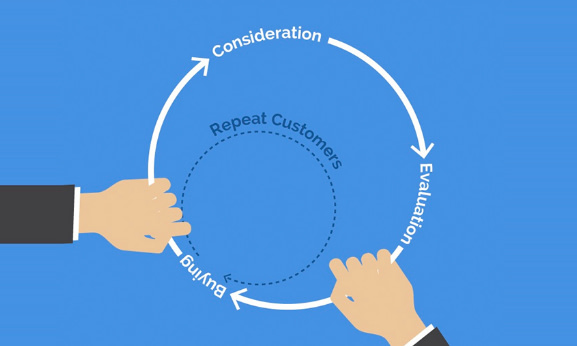
People often have attachments to brands. Up to 76% of shoppers say they would choose a brand they personally connect with over a competitor. So, once someone has entered the loop, you have a good chance of keeping them there.
You can keep customers in the loop with strategies like:
- VIP programs
- Loyalty rewards
- Private Facebook groups
- Excellent customer service
- Interaction on social media
- Creating buzz for new releases and products
Want an example of brand loyalty? Frank Green is a company that has created a loyal following of drink-bottle connoisseurs. From school students to professionals, the humble drink bottle is now a must-have item.
Frank Green bottles aren’t the cheapest, and there are other brands with very similar products. But clever marketing and customer connection sets Frank apart.
Environmentally friendly designs, unique colour-blocking hues, social media media campaigns and influencers hook the audience into the funnel. Once they’re there, the Frank Friends Inner Circle keeps customers in the loyalty loop.
How to Build a Successful Digital Marketing Funnel
Digital marketing comes with a range of benefits, including the ability to directly target and connect with your audience. The downside is that there is fierce competition. Even if you engage potential customers at the top of the funnel, you can still lose them along the way.
Digital marketing should never be a guessing game. Careful planning is required if you want to make the most of your marketing budget.
With the following strategies, you can build a digital marketing funnel that works:
1. Know Your Audience
We’ve mentioned the importance of customer research. But, how do you know who your customers will be?
Every brand should have a business plan that includes a target audience. You already know what you’re selling, you just have to match it to your ideal shopper. You can break your audience into four market segments:
- Demographic: Age, gender, marital status, race, education, income
- Psychographic: Interests, values, opinions, hobbies, personality type
- Geographic: Physical location, city/regional/remote, nearby amenities, transport, resources
- Behavioural: Purchasing habits, existing brand loyalty, the influences behind spending
It’s okay to cast a wide net here. The marketing activities at the top of your funnel should be aimed at a broad audience. This gives you the best chances of reaching potential customers and guiding them to the next stage of the process.
To do this, your audience research needs to include information about where your customers hang out. Do they use Facebook and Instagram every day? Are they performing searches through Google? Do they visit specialty websites you can target with Google Ads?
This information can inform your digital marketing strategy and help you make the most of your budget.
2. Improve Your User Experience
We need to make it as easy as possible for a prospect to become a customer. This is primarily done by improving the user experience of your website.
When a customer lands on your website, the first thing they see should be the information they’re searching for. If a potential customer makes it to your site and sees a fluorescent, flashing yellow sign that shouts “BUY THIS NOW” your chance of conversion will be low.
You may get a sale or two. But, unless you’re selling a cult item like the Kylie Jenner Lip Kits (these beauties broke the internet in 2016), your visitors may need a little more convincing.
Figure out what customers want and how you can connect with them.
This looks a little different for every brand. In some cases, customers want detailed information about the products they’re purchasing. They want to connect with your brand on a personal level and speak to a real person about their concerns.
Other times, customers want a simple process that allows them to make a purchase in as little time as possible.
It’s up to you to figure out what your audience wants. If you’re unsure, try asking some of your past customers what they enjoy about dealing with your brand!
3. Provide Valuable Content
Content is a core part of your top-of-funnel strategy. There are different types of content to choose from, including:
- Blog posts
- Social media
- Landing pages
- Email newsletters
- Guides and ebooks
- Podcasts and videos
There are a few rules to follow. For example, if you want to build brand awareness, your content should be relevant, educational and informative. It shouldn’t feel like a pushy sales pitch.
Let’s say you have a haircare brand. Your content may include informative blog posts, such as “Top hair trends for 2024” and “How to wash curly hair.” YouTube videos may also play a role, with tutorials for “fringe cutting” or “wedding updos.” In this scenario, you’ll be showing off your expertise while putting your customers first.
Of course, a few product suggestions won’t go astray if they add value, but it shouldn’t be the main focus of your content.
4. Drive Repeat Traffic
Not all sales are instant.
To seal the deal, you’ll need to stay on the customer’s radar during the Awareness and Discovery phases. Driving repeat traffic to your website will be beneficial, as it gives users the chance to get to know your brand before they commit.
Having a large reach at the top and middle levels of your funnel will have a flow-on effect. For example, if you start with 100 visitors, you may end up with 10 sales. But if you have 1,000 visitors, you may end up with 100 sales.
One of the best ways to drive repeat traffic is with remarketing.
Have you ever searched for something and then received related ads at every turn? That’s remarketing in action. It’s a very effective way to encourage previous visitors to come back to your site.
You can also drive repeat traffic by getting to the top of Google’s organic search results. Over 90% of consumer traffic goes to web pages that are listed at the top of Google. Getting into those top spots takes time and a good SEO strategy, but it’s the best way to drive traffic to your website in the long-term.
5. Create Clear Brand Messaging
Clear brand messaging makes your products memorable and recognisable. You can create a clearer brand using the three Cs:
Consistency
New and existing customers should know what to expect at every step of the digital marketing funnel.
Whether it’s published on social media or your website, your branding should always be the same. This includes brand names, logos, colours, imagery and even the tone of voice you use.
Defining your brand voice is a big topic that comes down to your target audience. For example, Starbucks describes its brand voice as “Functional” and “Expressive.”
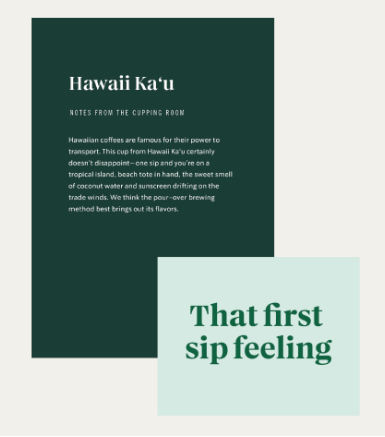
You’ll also notice the use of consistent colours that appear throughout Starbucks’ branding.
The quality of your content should be consistent too. Stick to the same structure and tone, and always connect it back to your audience. This makes your content easier to read and helps customers find the information they need.
Clarity
Clarity is a priority at every stage of the marketing funnel.
Your marketing should communicate in clear, direct terms. Let customers know who you are, what you do and why they need your products or services.
Think about what you sell and why your customer can’t live without it.
For example, let’s look at Array Bags, a store that only sells tote bags. Why would a customer buy these specific bags? Well, these accessories are Insta-favourites, they’re designed in Australia and they come with a zip and pockets.
The brand also has a secret for retaining customers at the bottom of the funnel. The bags come in multiple colours and have a mid-level price point, so customers will buy one to match every outfit!
Remember, you only have an instant to capture the attention of a consumer. Whether it’s choosing keywords for SERPs, GoogleAds or social media posts, every word counts. And, when visitors do hit your landing page, it should have concise copy and an obvious CTA.
Character
The third “C” is Character.
Don’t be afraid to show some personality! Especially when it comes to social media. For example, leading brands often use memes and funny Tweets for share-ability.
Keep in mind, this strategy only works with an appreciative audience. Netflix can get away with humour, while a health brand like Pfizer probably can’t.
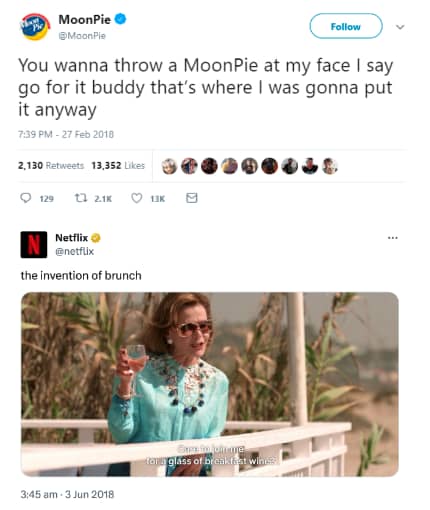
Character also reflects the company’s values. You may pride yourself on the way you treat customers, fast delivery times or affordable prices. Or your brand may be passionate about the environment and a supporter of ethical fashion.
These values can be showcased on your “About Us” page and sprinkled throughout the content you produce.
6. Capture Leads
If you are driving visitors to your website at the top of the funnel, don’t let them get away. The process of turning “visitors” into “leads” is called “lead capture.”
Consumer data is invaluable, and even a name and email address can support your digital marketing efforts. There are a range of opportunities for collecting this information at the top of the funnel. For example:
- Offering a free downloadable on landing pages
- Offering a discount for new email subscribers
- Asking users to sign up to your newsletter
Customer details can also be captured at the bottom of the funnel, during the checkout process. If the cart is abandoned, you will have their email address for remarketing. And, if the sale goes through, you can remind them to come back for more.
You should never underestimate the power of your email list. If a lead is on the verge of buying, a special offer in their inbox could be enough to seal the deal. Of course, our inboxes are often overflowing, so don’t bombard your leads. Make sure anything you send is high quality, actionable and relevant.
These days, your emails can be automated and triggered by user actions. For example, if a cart is abandoned an email saying “Left something behind?” can land in their inbox.
Remember, you should never sign someone up to your email list without their permission. This can be as simple as a checkbox to “opt-in.”
7. Set Clear Goals
Clear goals help to understand how well your digital marketing funnel is performing.
Every stage of the funnel serves a different purpose, and your goals should match. If you notice you’re not meeting goals in one area, you’ll know exactly what to focus on.
Your goals should be realistic and achievable. They may look like this:
Awareness Goals
During this phase, the obvious goal is to gain website visitors. It’s about generating interest and growing your audience at the top level.
Focus on traffic and brand recognition – you will have the chance for more targeted marketing as the funnel narrows.
The Google Search Console will give you insights into performance, indexing and experience. If any of your pages aren’t performing as well as they could, it’s time to make improvements. For example, potential customers will be turned away by slow loading speeds or poor navigation. Fix these issues as soon as possible, before you lose a sale.
Discovery Goals
Discovery is the second phase. The goal is to take casual browsers and turn them into serious shopping candidates.
Google Analytics will show you whether those initial visitors are coming back. You can also monitor how long they are spending on page and the journey they take. For example, are they visiting multiple pages during their research, or are they leaving your page after a few seconds?
During this phase, you can also grow your social media profiles and email marketing lists. Your goal may be to grow your socials by 1,000 followers a month, or your email list by 100 subscribers a month.
Conversion Goals
At the bottom of the funnel, the goal is to turn your leads into sales. You may have a specific number of sales you’re aiming for each quarter. Or, your target may be a dollar amount.
The best way to meet your conversion goals is with a strong digital marketing funnel. By meeting your Discovery and Awareness goals, the chance of securing a sale will be improved.
Retention Goals
Finally, you’ll have retention goals. These will celebrate repeat business.
For example, a retention goal may be having 50% of shoppers return within 6 months. Or, if you have a subscription service, you may aim for an unsubscribe rate of less than 20%.
If you’re not getting these results, your after-sale service may be letting you down.
Building a Digital Marketing Funnel
Digital marketing funnels are not a new concept. But for most marketers, they are an essential part of the sales toolkit.
Your funnel can be broken down into four phases. Awareness comes first, as customers get to know that your brand exists. It’s the biggest part of the funnel because you’ll have a wide target audience.
Next is Discovery, where interest is piqued and the audience is considering your product or service. It’s a smaller segment than Awareness, and not every visitor will translate into a sale.
Conversion comes next, where the sale is secured. The last phase of the funnel is Retention, and the focus here is customer loyalty.
Getting your target audience from the top of the digital marketing funnel to the bottom requires goal setting, customer research and planning. Once that’s done, you’ll also need to map out marketing activities and campaigns that correspond to each funnel segment.
It’s a challenge, but developing, growing and troubleshooting a marketing funnel ensures the long-term success of your business.
If you’re unsure where to start, the team at Gordon Digital would love to help!
Gordon Digital is a digital marketing agency that specialises in strategy. Your success is our success, which is why we tie each service to your overall marketing strategy. We’ll make sure every dollar you spend goes towards turning potential customers into your biggest fans.
Book a discovery session to find out how we can support your business growth!

